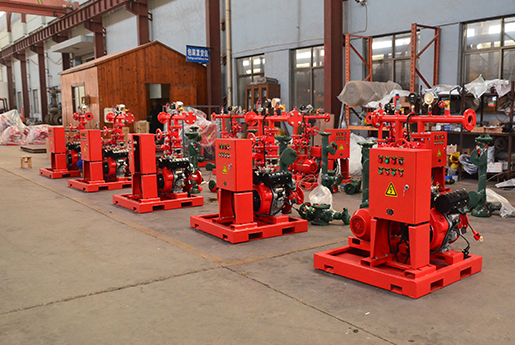How are fire pump systems integrated with emergency power systems to ensure continuous operation during power outages?
Jan 10, 2024
Share:
Integrating fire pump systems with emergency power systems is critical to ensure continuous operation during power outages, as these systems play a crucial role in fire protection. Here are common methods used to achieve this integration:
1. **Emergency Power Source:**
- Fire pump systems are often connected to emergency power sources such as standby generators. These generators automatically start in the event of a power outage, ensuring a reliable power supply to the fire pump.
2. **Automatic Transfer Switch (ATS):**
- An ATS is a device that detects the loss of normal power and automatically transfers the load, including the fire pump system, to the emergency power source. This transition is seamless and occurs within seconds.
3. **Dedicated Electrical Circuits:**
- Fire pump systems are typically connected to dedicated electrical circuits to ensure that other non-essential loads do not affect the availability of power during an emergency.
4. **Monitoring Systems:**
- Integrated monitoring systems continuously track the power status and operational readiness of both the fire pump system and the emergency power source. Alerts are generated if any issues are detected.
5. **Regular Testing and Maintenance:**
- Regular testing of the emergency power system and fire pump is essential to verify their functionality during simulated power outages. Routine maintenance ensures that all components are in optimal condition.
6. **Fuel Supply for Generators:**
- Standby generators require a reliable fuel supply. Adequate fuel storage and monitoring systems are essential to ensure the availability of fuel during extended power outages.
7. **Code Compliance:**
- Integrating fire pump systems with emergency power sources must comply with relevant codes and standards. For example, the National Fire Protection Association (NFPA) provides guidelines (e.g., NFPA 20) for the installation and operation of stationary fire pump systems.
8. **Battery Backup:**
- In addition to generators, some fire pump systems may have battery backup systems. These batteries provide short-term power to the fire pump during the transition to the emergency power source.
9. **Remote Monitoring and Control:**
- Remote monitoring systems allow operators to monitor the status of fire pump systems and emergency power sources from a central location. This enables quick response to any issues that may arise.
10. **Redundancy:**
- Redundancy measures, such as backup generators or dual power sources, may be implemented to further enhance the reliability of the emergency power supply for fire pump systems.
Integrating fire pump systems with emergency power sources requires careful planning, adherence to standards, and regular maintenance to ensure the continued functionality of these critical components during power outages and emergency situations.

1. **Emergency Power Source:**
- Fire pump systems are often connected to emergency power sources such as standby generators. These generators automatically start in the event of a power outage, ensuring a reliable power supply to the fire pump.
2. **Automatic Transfer Switch (ATS):**
- An ATS is a device that detects the loss of normal power and automatically transfers the load, including the fire pump system, to the emergency power source. This transition is seamless and occurs within seconds.
3. **Dedicated Electrical Circuits:**
- Fire pump systems are typically connected to dedicated electrical circuits to ensure that other non-essential loads do not affect the availability of power during an emergency.
4. **Monitoring Systems:**
- Integrated monitoring systems continuously track the power status and operational readiness of both the fire pump system and the emergency power source. Alerts are generated if any issues are detected.
5. **Regular Testing and Maintenance:**
- Regular testing of the emergency power system and fire pump is essential to verify their functionality during simulated power outages. Routine maintenance ensures that all components are in optimal condition.
6. **Fuel Supply for Generators:**
- Standby generators require a reliable fuel supply. Adequate fuel storage and monitoring systems are essential to ensure the availability of fuel during extended power outages.
7. **Code Compliance:**
- Integrating fire pump systems with emergency power sources must comply with relevant codes and standards. For example, the National Fire Protection Association (NFPA) provides guidelines (e.g., NFPA 20) for the installation and operation of stationary fire pump systems.
8. **Battery Backup:**
- In addition to generators, some fire pump systems may have battery backup systems. These batteries provide short-term power to the fire pump during the transition to the emergency power source.
9. **Remote Monitoring and Control:**
- Remote monitoring systems allow operators to monitor the status of fire pump systems and emergency power sources from a central location. This enables quick response to any issues that may arise.
10. **Redundancy:**
- Redundancy measures, such as backup generators or dual power sources, may be implemented to further enhance the reliability of the emergency power supply for fire pump systems.
Integrating fire pump systems with emergency power sources requires careful planning, adherence to standards, and regular maintenance to ensure the continued functionality of these critical components during power outages and emergency situations.


.png)
.png)

.png)


